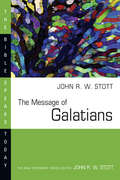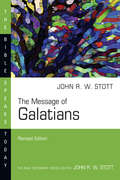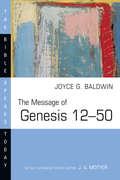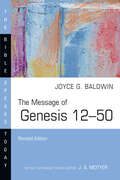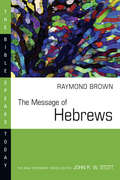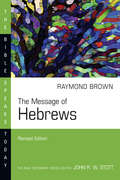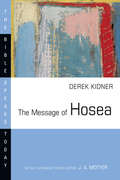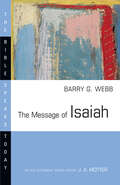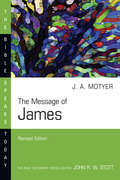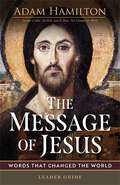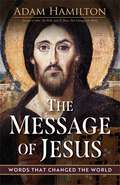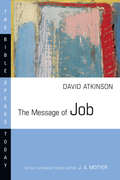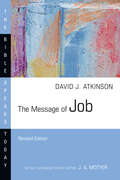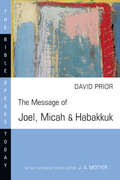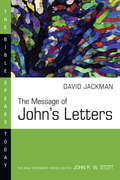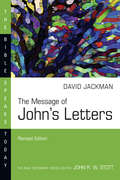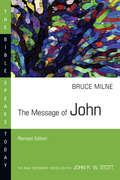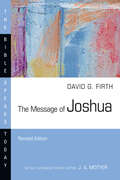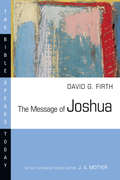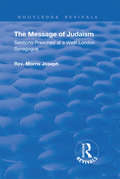- Table View
- List View
The Message of Galatians: Only One Way (The Bible Speaks Today Series)
by John StottTo enclaves of young converts tucked away in the mountains of Asia Minor, Paul wrote what is perhaps the oldest document in the New Testament--the letter to the Galatians. What problems were they facing? Among a variety of religious authorities espousing different teachings, how were they to know who was right? How were men and women to be put right with God? How could Christians in the midst of a pagan culture live lives truly pleasing to God? 'Only one way--' answered Paul, 'through Jesus Christ.' His answer holds true for us as well. The details of our struggle have changed since Paul's day, but the principles he sets forth are as timeless as the Lord he exalts. In this book John Stott helps us to understand and apply the message of Galatians in the face of contemporary challenges to our faith.
The Message of Galatians: Only One Way (The Bible Speaks Today Series)
by John StottTo enclaves of young converts in the mountains of Asia Minor, Paul wrote what is perhaps the oldest document in the New Testament—the letter to the Galatians. Paul's readers were struggling with numerous issues: How were men and women to be put right with God? Among a variety of religious authorities espousing different teachings, how were they to know who was right? How could Christians in the midst of a pagan culture live lives truly pleasing to God? Only one way, answered Paul: through Jesus Christ. In this volume, John Stott helps us understand the message of Galatians and how it holds true in the face of current challenges to our faith. Guiding readers passage by passage through Galatians, he provides helpful background, highlights key themes, and offers applications for Christians today. This revised edition of a classic Bible Speaks Today volume features a new interior design, updated Scripture quotations, and light updates throughout.
The Message of Genesis 12–50: From Abraham To Joseph (The Bible Speaks Today Series)
by Joyce G. BaldwinAbraham—called out of Ur of the Chaldeans to go to Canaan, there to found a great nation, a blessing to all peoples. Isaac—his son, taken to be sacrificed by his father, until God provided a substitute. Jacob—Isaac's son, the schemer who cheated his older brother of his birthright but whose thigh (and heart) was broken as he wrestled all night with God's messenger. Joseph—the dreamer sold into Egypt by his brothers, who meant it for evil while God meant it for good. These are the patriarchs whose stories are told in Genesis 12–50. Why have these accounts been preserved? What importance do they have in the development of Israel's understanding of God? What message from them does God have for us today? In this Bible Speaks Today volume, Joyce Baldwin skillfully weaves her answers to these questions, bringing the history of an ancient people to bear on our lives.
The Message of Genesis 12–50: From Abraham To Joseph (The Bible Speaks Today Series)
by Joyce G. BaldwinGenesis sets the scene for the whole of the Bible, and indeed the entire human drama. It is a book both of beginnings and of a new beginning—the dawn of the gospel. In this Bible Speaks Today commentary, Joyce G. Baldwin shows how the vivid narratives of Abraham, Isaac, Jacob, and Joseph still speak to us today, highlighting God's ways of dealing with ordinary, imperfect people in fulfilling his great plan for the whole of humanity. Baldwin explores the meaning Genesis 12–50 offers Christians today—and how the often painful experiences it relates help us to better know the character of the God we worship. Part of the beloved Bible Speaks Today series, The Message of Genesis 12–50 offers an insightful, readable exposition of the biblical text and thought-provoking discussion of how its meaning relates to contemporary life. Used by students and teachers around the world, The Bible Speaks Today commentaries are ideal for those studying or preaching the Bible and anyone who wants to delve deeper into the text. This beautifully redesigned edition has also been sensitively updated with more current references and the NRSV Bible text.
The Message of Genesis 1–11 (The Bible Speaks Today Series #Vol. 1)
by David J. AtkinsonGenesis shows us how and why we are. It uncovers the origins of evil. It illuminates the meaning of freedom. It expresses the harmony of creation. And it offers hope for the renewal of our natural world and for the healing of our broken relationships. "Genesis 1–11 is really an overture to the rest of the Bible." So writes David Atkinson in his introduction to this thoughtful and spiritual guide to the opening chapters of Genesis. Writing as a scientist and as a pastor, Atkinson avoides technicalities and speculation and provides a skillful guide to the text's theological significance. While many commentaries on these chapters become tangled in problems of dating, authorship and historicity, this Bible Speaks Today volume on the opening chapters of Genesis focuses on the issues that really matter. Atkinson's work will be a delight to all—seasoned expositors and novice readers alike.
The Message of Genesis 1–11 (The Bible Speaks Today Series)
by David J. AtkinsonWhere do we come from? What is our purpose? The key to how and why we are is found in the early chapters of Genesis. In The Message of Genesis 1–11, David Atkinson explores how the first eleven chapters serve as an overture to the rest of the Bible. They evoke wonder as God is portrayed in his creative power and beauty. They reveal God's loving mercy and salvation, even in his terrible judgment of those who turn from him and despoil the harmony of creation. With vivid insight, this Bible Speaks Today commentary illuminates how the meaning of Genesis is still resonant today—helping us understand both the greatness and the tragic flaw inherent in human beings. Although it was written thousands of years ago, the message of Genesis is one of timely urgency for the modern world: we are responsible participants in God's creation who must, like Noah, confront the possibility of global catastrophe. Part of the beloved Bible Speaks Today series, The Message of Genesis 1–11 offers an insightful, readable exposition of the biblical text and thought-provoking discussion of how its meaning relates to contemporary life. Used by students and teachers around the world, The Bible Speaks Today commentaries are ideal for those studying or preaching the Bible and anyone who wants to delve deeper into the text. This beautifully redesigned edition has also been sensitively updated with more current references and the NRSV Bible text.
The Message of Hebrews (The Bible Speaks Today Series)
by Raymond BrownTimes were hard for the first readers of the letter to the Hebrews. Many had been exposed to fierce persecution. They had been assaulted, their homes had been plundered, and some had even been cast into prison. To such people this letter came as an encouragement. The writer of the letter turns their eyes to Christ, shows how he fulfills the hope expressed in the Old Testament sacrifices, and calls his readers to a steadfast faith that will take them through the hard times they now face. Such encouragement and challenge are never without relevence to Christians. Raymond Brown demonstrates this clearly in his passage-by-passage exposition.
The Message of Hebrews (The Bible Speaks Today Series)
by Raymond BrownThe first-century readers of Hebrews were at a critical point. Many had been exposed to public ridicule, persecution, and imprisonment. Some had already abandoned their commitment to Christ, and others were in danger of compromising or giving up. The letter to the Hebrews brought a profound encouragement and appeal: they must keep their eyes on Christ and remain anchored in the truth. In this Bible Speaks Today volume, Raymond Brown guides readers passage by passage through Hebrews, exploring historical background, key themes, and applications for today. While some find Hebrews one of the most puzzling of the New Testament books—with its references to animal sacrifices and ancient Israelite customs—Brown identifies a timeless message that remains strikingly relevant in each generation. As Hebrews celebrates the uniqueness of Christ, it clarifies Christians' priorities and our only hope for faithful endurance. This revised edition of a classic Bible Speaks Today volume includes updated language and Scripture quotations and a new interior design.
The Message of Hosea (The Bible Speaks Today Series)
by Derek Kidner"Go and marry a prostitute." These are the first words God spoke to his prophet Hosea. Why would he ask this of one of his special spokesman? Because he wanted to teach Hosea, the nation of Israel and all of us today a lesson we will not forget, a lesson that is painful yet joyous. Hosea's somber portrait of the human condition is our lesson in pain. All of us have played the harlot by forsaking God and his ways. The picture is not pretty but it's true. Yet Hosea clear illustration of God's love for us brings joy. While we are yet sinners, God comes to us and loves us. Derek Kidner imaginatively takes us through the unfolding story of Hosea and his wife, Gomer explaining the basic message, pointing out the subtleties and encouraging readers to live lives worthy of the God who loves the loveless.
The Message of Isaiah: On Eagle's Wings (The Bible Speaks Today Series)
by Barry G. WebbEver since Jesus read from the scroll of Isaiah in the synagogue of Nazareth, Christians have gravitated to this great prophecy as the interpretive center of the Old Testament. Here the story of Israel, scourged by judgment and exile and hopeful of restoration, is framed by its witnesses, heaven and earth. How will Israel be brought through its school of suffering and be propelled toward its divine destiny as the vanguard of a new heaven and earth? In the visionary world of Isaiah, the varied themes and imagery of the Old Testament converge and blend to transcend their plainest meanings as they project an extraordinary climax of the story of Israel and of the world. Barry Webb calls Isaiah the "Romans" of the Old Testament, where all the threads come together and the big picture of God's purposes for his people and for his world are most clearly set forth. Attuned to the magnificent literary architecture of Isaiah, Webb escorts us through this prophecy and trains our ears and hearts to resonate with its great biblical-theological themes.
The Message of James (The Bible Speaks Today Series)
by J. Alec MotyerAs a good communicator, James addressed his readers directly and pointedly with vivid images from ordinary life and attention-gripping statements. This rich exposition brings James's letter to life for today's reader. Alec Motyer is himself gripped by James's energy and concern for practical Christianity.The letter shows how a genuine faith is a tested faith, how encounter with difficulties is an essential part of the growth to Christian maturity this book powerfully brings out James's memorable themes--the link between enduring trials and maturity; the question of perfection; the good gifts of God; faith, works and Christian concern in a world of human need; the implications of careless and evil words; the meaning of war; the church and healing; confession of sin; and the need for active purity in life.
The Message of James (The Bible Speaks Today Series)
by J. Alec MotyerThe apostle James addressed his readers directly and pointedly, using vivid images from ordinary life and attention-gripping statements. His letter reveals how a genuine faith is a tested faith, and how encountering difficulties is an essential part of the growth to Christian maturity. In this Bible Speaks Today volume, J. Alec Motyer's rich exposition brings James's letter to life for today's readers. Motyer is himself gripped by James's energy and concern for practical Christianity. He draws out the book's memorable themes: the link between enduring trials and maturity; the good gifts of God; faith, works, and Christian concern in a world of human need; the implications of careless and evil words; the church and healing; confession of sin; the need for active purity in life; and more. This revised edition of a classic BST volume includes a new interior design, lightly updated language, and updated Scripture quotations throughout.
The Message of Jesus Leader Guide: Words That Changed the World
by Adam HamiltonA fresh encounter with the words of Jesus.This Leader Guide contains everything needed to facilitate a 6-week study on The Message of Jesus, by Adam Hamilton. Helps include opening prayers, summaries, discussion questions and more.More than 3 billion people claim to follow Jesus. But aside from a few verses, how many actually know what he taught? In fact, much of what people think Jesus taught, he never said. In this six-week study, pastor and best-selling author Adam Hamilton explores six of the most important themes in Jesus's teachings, why they matter, and how they speak to us today. The book will explore Jesus’s preaching on the Kingdom of God, the Sermon on the Mount, the parables, the “I am” sayings in John, and more. Jesus's message is not only life-changing, but world-changing. Join Adam Hamilton in studying The Message of Jesus: Words That Changed the World. Other components for the study include a leader guide, and teaching video are available.
The Message of Jesus: Words That Changed the World
by Adam HamiltonA fresh encounter with the words of Jesus.More than 3 billion people claim to follow Jesus. But aside from a few verses, how many actually know what he taught? In fact, much of what people think Jesus taught, he never said. In this six-week study, pastor and best-selling author Adam Hamilton explores six of the most important themes in Jesus's teachings, why they matter, and how they speak to us today. The book will explore Jesus’s preaching on the Kingdom of God, the Sermon on the Mount, the parables, the “I am” sayings in John, and more. Jesus's message is not only life-changing, but world-changing. Join Adam Hamilton in studying The Message of Jesus: Words That Changed the World. Other components for the study include a leader guide, teaching videos, and sermons and worship.
The Message of Job (The Bible Speaks Today Series)
by David J. AtkinsonWhy do people suffer?What is God's role in suffering?How can we help those who suffer?
The Message of Job (The Bible Speaks Today Series)
by David J. AtkinsonWhy do people suffer? What is God's role in suffering? How can we help those who suffer?The book of Job is all about human suffering. Its portrayal of one man's anguish, the ineffective responses of his friends, and his struggle for faith and understanding mirrors our own experiences in the world.David Atkinson offers a pastoral exploration of Job's story. His compelling exposition shows the power of the book of Job to reach into our human situation and engage with our human needs. It offers, he believes, the strong comfort that comes from knowing someone else has been there before. The message of Job is both a comfort to us in our own suffering and a model for our ministry to others in pain.The Message of JobThis revised edition of a classic volume features lightly updated language and current NIV Scripture quotations with a new interior design.
The Message of Joel, Micah and Habakkuk: Listening To The Voice Of God (The Bible Speaks Today Series)
by David PriorWhere is God in times of disaster? How can God allow suffering? What are God's people to do about moral decay in society? While people throughout the ages have long pondered these questions, three of the minor prophets--Joel, Micah and Habakkuk--provide insights to these perennial problems. The people of Joel's day were devastated by a locust plague, which Joel said warned of the coming Day of the Lord. Micah rebuked a culture of corruption and moral evil. Habakkuk cried out to the Lord on account of a society bent on violence. All three point to a transcendent God who gives hope in times of uncertainty. David Prior's passage-by-passage exposition of these three books provides careful study and measured insight and application for today's church.
The Message of John's Letters (The Bible Speaks Today Series)
by David JackmanImmorality is inudating the Christian community and gradually eroding the foundations of Christian living. The truth of God incarnate, the atonement and the bodily resurrection of Christ are under attack--even from within the church. These are the concerns of Christians today, and they were the problems that faced the Christians of John's day. In a society that scorned the gospel and sneered at godly living, John encouraged Christians with a message forged from two words--truth and love. In this contemporary retelling of John's message, David Jackman describes John's first letter as an upwardly spiraling staircase that circles and broadens out around the twin themes of truth and love, mind and heart, Word and Spirit. It is a message both timeless and timely for the church today.
The Message of John's Letters (The Bible Speaks Today Series)
by David JackmanImmorality inundating the Christian community and gradually eroding the foundations of Christian living. The truth of God incarnate, the atonement, and the bodily resurrection of Christ under attack���even from within the church. These were the problems that faced the Christians of John's day. In a society that scorned the gospel and sneered at godly living, John encouraged Christians with a message forged from two words: truth and love. The concerns of John's original readers are still the concerns of the church now. In this accessible retelling of John's message, David Jackman provides historical background, identifies key themes, and offers applications for today. He describes John's first letter as an upwardly spiraling staircase that circles and broadens out around twin themes of truth and love, mind and heart, Word and Spirit. It is a message both timeless and timely. This revised edition of a classic Bible Speaks Today volume includes updated language and Scripture quotations and a new interior design. A study guide for individuals or groups is included to help readers engage more deeply with the text.
The Message of John: Here Is Your King! (The Bible Speaks Today Series)
by Bruce MilneJohn's Gospel has long been a favorite among Christians.The Message of John
The Message of Jonah: Presence in the Storm (The Bible Speaks Today Series)
by Rosemary NixonThe book of Jonah is mostly remembered for its oddity—a runaway prophet swallowed by a whale! But there must be more to the book than that. And indeed there is. For one thing, it is a book artfully constructed, with one chapter devoted to a psalm. It is a book that will reward careful reading and meditation. But more than that, in the drama of Jonah we find charted the course not just of this angular prophet but of Israel's attitude toward its most despised neighbor in the Mediterranean world. Jonah refuses to answer God's call to go and proclaim judgement because he knows God is just the kind of God who respond in mercy and grace should the Assyrians repent. Jonah will have no part of it—until he is compelled. And even then he pities himself. The irony of this prophet's story is amusing—but it reaches out and touches us where we are today. Rosemary Nixon's exposition explores the book in its own right and helps us make the connections with our view of God and his world today.
The Message of Joshua (The Bible Speaks Today Series #Available December)
by David G. FirthThe book of Joshua tells the action-packed story of Israel's entry into and conquest of Canaan, the promised land. Yet it is often troubling for contemporary Christian readers, perhaps more than any other part of the Old Testament: isn't there too much violence, and isn't this violence inconsistent with the gospel of Jesus? In The Message of Joshua, David G. Firth explores this story as part of God's mission, which goes on to find its ultimate focus in Jesus Christ. He illuminates the meaning that the book of Joshua still has for Christians today. It challenges us, just as it challenges those who have read it down through the ages, to recognize that God not only includes those who join him in his mission, but he also excludes those who choose to set themselves against it. Part of the well-loved The Bible Speaks Today series of commentaries, The Message of Joshua offers a clear, readable exposition of the biblical text and thought-provoking discussion of how its meaning relates to contemporary life. Used by Bible students and teachers around the world, The Bible Speaks Today commentaries are ideal for anyone studying or preaching Scripture and those who want to delve deeper into the text. This beautifully redesigned edition has also been sensitively updated to include modern references and the current NRSV Bible text.
The Message of Joshua: Promise And People (The Bible Speaks Today Series #Available December)
by David G. FirthPreaching's
The Message of Judaism: Sermons Preached at a West London Synagogue (Routledge Revivals)
by Morris JosephPublished in 1908, this book draws on a variety of sermons written by Rev. Morris Josephs, to provide a message on Judaism. Designed to create a discourse for universal readership this book covers topics such as the ethics of Jewish life, the perception of the world vs Judaism, and the religious experience of Judaism.
